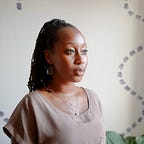Urban Up Close: I Found Some Brown & Black People
Many times throughout my life — private education, living in and traveling to European cities, working for tech companies — I have been one of, or the only person of color in the room. Whether in a classroom, a cafe, or at an event I am keenly aware that I am the only person of my race or ethnicity. To the majority, their skin color or nationality is normative, a luxury they take for granted. They are able to consume in the city without hassle or without being stared at because almost everyone around them looks like them.
It happened by accident, but also on purpose. I agreed to enter a poetry slam for the Vienna African Writers Club. During that auspicious night, winning 2nd place, I met many poets, but two were exceptional. One of the poets is from Brasilia, Brazil and performed three very moving poems in Portuguese. Although I did not understand the words, I felt the meaning and the heart. The poet who won first place, an Austrian-Nigerian having grown up in Austria and the UK, has a wonderful British accent, and her poems were astute and deliberate. Also, at this event there were Ghanians, Zambians, Kenyans, Nigerians, Austrians, and other brown and black people. I found them! For the first time since I’ve been in Vienna the white people in the room were the minority.
The very next night, I was invited to perform at a poetry slam being recorded live at a Vienna radio station. The two women aforementioned invited me out of good faith and a mutual love of poetry, identity, diaspora, and women. I walked into this Viennese community station and into a small studio filled with brown women, black women, white women, and a couple of white men. There’s more of us! The studio was humid, filled with so many words and rhythms. This was a multilingual poetry slam for brown and black women from the African Diaspora (in Vienna) to perform our poetry on a Viennese radio station. The languages represented were English, German, Portuguese, and Arabic. At the end of this event I, along with eight other performers, was gifted a nice plant, which now sits on the table in my apartment.
Those two events, those two nights, was the first time in my two months here I felt like I was around my people. Not only because we shared the same identity as being people from (and who care about) the African Diaspora, but also because I was surrounded by people who understand the power of art and activism to carry stories across countries, oceans, and experiences. I was around people who do not believe white europeans, or white Americans, or any dominant group is normative as opposed to us — “the others” — as abnormal. In that room, being a women from the African Diaspora was the norm. I liked that. In the middle of 20th district in Vienna I was in a room where I was not being seen because I am different, I was there to celebrate and critique the idea of difference.
In the evening before the Vienna African Writers Club poetry slam, I took a walk across the Danube on a bridge that connected Vienna to Donau City. Donau City, or DC as the advertisements in the metro call it, is a relatively new development on the edge of Vienna, across the Danube. DC is home to United Nations Headquarters, the Vienna International Center, and some multinational corporations. DC is considered an “edge city” since it is an urban development built on the edge of the city of Vienna. It is attempting to be an urban center, with little success. People who don’t live or work in DC do not come there often, as there’s not much to do.
Before that sunset walk across the Danube with two members of my cohort, we were sitting next to a huge black tower in the DC complex learning about its development, Austrians voting no to almost every referendum put forth by the city of Vienna, and the reemergence of multiple urban centers. The sun was shining and warm and in that moment I could really take in, accept, the full beauty of Vienna even though the modern architecture and ridiculously high buildings of DC does not to the city much justice. I witnessed the combining of old and new. Just across the river there were buildings built during Red Vienna in the 1920’s, and I was sitting in the shadow of a 220 meter building (the highest skyscraper in Vienna) that officially opened in 2014. The contrasts in this city are so apparent to me. That afternoon while in DC I was a minority, and by the evening I was a majority.
I’m scheduled to do a few more poetry performances while in Vienna and very excited about seeing more of the brown and black culture here. The city is a place of heterogeneity, and sometimes it’s hard to find, especially in cities like Vienna that have a history of homogeneity. In the midst of all of this, I can find myself performing in a transnational, multilingual, female-centric poetry poetry slam that reached across cultures and borders to find a common identity in a city like Vienna.
